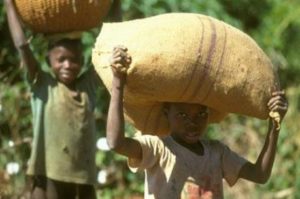Brong Ahafo tops child labour cases in Ghana
 The Ghana Living Standard Survey Round Six, conducted by the Ghana Statistical Service, indicates that 8,697,602 children aged five to 17 are engaged in economic activities, out of which 21.8 per cent constitute child labour with 14.2 per cent in hazardous work.
The Ghana Living Standard Survey Round Six, conducted by the Ghana Statistical Service, indicates that 8,697,602 children aged five to 17 are engaged in economic activities, out of which 21.8 per cent constitute child labour with 14.2 per cent in hazardous work.
The Brong Ahafo Region recorded 302,972 children, representing 33.5 per cent, the Central Region recorded 70, 535 children, representing 8.9 per cent, with the Greater Accra Region being the lowest with 62,526 children, representing 5.2 per cent of children engaged in child labour and hazardous work.
Alhaji Adams Nuhu, the Municipal Chief Executive of Awutu Senya East, speaking at this year’s World Day against Child Labour celebration at Kasoa, said the fact that the region recorded the lowest did not mean that stakeholders should rest on their oars.
“We need to come together to eradicate child labour in the region and concentrate on quality education which would position our children better in international realm in future.
“Awutu Senya East Municipality is not an exception to this problem. It is estimated that 1,657 children are engaged in child labour representing five per cent. This is one of our major challenges as a municipality and we all need to contribute in diverse ways to ensure that those involved are rescued from it,” he said.
The International Labour Organisation (ILO) has set aside June 12 each year as the World Day against Child Labour to draw world attention on the seriousness of child labour and the need for all stakeholders to work together to reduce or eradicate it.
This year’s celebration was on the theme; “End Child Labour in Supply Chains: It is Everybody’s Business” and was organised by the Awutu Senya East Municipal Assembly in collaboration with the Awutu Senya East Department of Social Welfare and Community Development to highlight the menace.
The ILO estimates that about 168 million children worldwide are in child labour, with 85 million of them in hazardous work.
In Sub-Saharan Africa 30.3 per cent of the population of children are engaged in economic activities. Out of that figure 21.4 per cent constitutes child labour whereas 4.7 per cent are engaged in hazardous work.
Alhaji Nuhu, therefore, called on stakeholders to contribute in diverse ways to ensure that children received quality education.
He also called on the public to be on the lookout for the perpetrators of the act in the communities so that they could alert the Social Welfare officials to rescue those children.
“You should be an agent of change as you go to your various homes to educate people on child labour and its effects,” he said, and urged children to value education more than to think about how to make quick money at the expense of their education.”
Mr Jacob Asiedu, the Head of the Department of Social Welfare and Community Development, said children were not only the future leaders but also the greatest hope of the nation and must be protected from any form of hazardous work.
He said the Government, over the years, had not relented in its efforts to protect and promote the welfare of children to enable them to take their rightful positions in the society.
“As government continues to play its role, it behoves on us as school children to also live up to expectation in all facets of societal life,” he said.
Mr Asiedu called for the formation of anti-child labour clubs in schools to sensitise the children on activities that constitute child labour, exploitation and hazardous work.
Source: GNA
